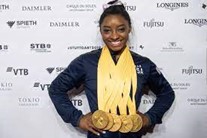Beneath the surface of ADHD, post 3: Superpower of ADHD in Sports
In writing this series about ADHD, I’ve been diving into the ADHD-athlete experience and learning more about high profile athletes that have spent their careers managing ADHD. What do you think: How many successful athletes have ADHD? If we were going to take a “not many” approach to answering this question, we’d probably focus on all the ways that ADHD could get in the way. One could mention that difficulty managing distractions, trouble concentrating, being late or not showing up at all, being inconsistent, all get in the way. And in some cases, this is true.
And, what about this: What do Simone Biles, Michael Phelps, Justin Gatlin, Michael Jordan, and Kevin Garnett all have in common?
They are diagnosed with ADHD; they were or are among the elite in their sport and are Olympic gold medalists. Oh, and we’re not talking just one-time medalists, as you can see in the pictures above.
In seeing these athletes, plus many other elite athletes that have a diagnosis, does this make you re-think any initial assumptions about if ADHD and being an elite athlete can co-exist together?
ADHD prevalence may be higher in elite athlete populations of adults than the general population, roughly 8.4% to 5% (Constance, 2020). Some estimates have the number as high as 20% (Linden, 2010). This may be counterintuitive to our assumption. But then maybe there is something appealing about sports for individuals with ADHD. For example, if you’re a parent: have you used sports as an outlet for your kids? If your answer is yes, maybe you’ve seen some of the positive benefits: giving the brain a way to find structure and routine, release energy, create small successes, and more. We at TOPPS believe sport can be a great outlet and a wonderful way to support mental well-being.
In this third post of the series, focusing on ADHD in sports, let’s look under the hood to see how the ADHD brain – “a Ferrari for a brain with bicycle breaks” as Dr. Ned Hallowell describes it – can be a secret weapon, even a superpower, for elite athletes. And what this could mean for you – whether you’re a coach, a parent of an ADHD athlete, or an ADHD athlete yourself.
There’s no secret recipe for what it takes be a successful athlete. For one, we’re all different. And two, some of it comes from luck, timing, and opportunities. Regardless of the strengths and talents we all have, they still must be harnessed in a productive direction.
We can find many ways in which ADHD traits, when one has the tools to harness these powers, can be helpful for being a successful athlete:
· Inattention, or the ‘hyperfocus towards what one finds interesting,’ can develop passion and curiosity. This can be a superpower when it is channeled with intensity and desire towards something that one finds stimulating.
· Hyperactivity can yield energy and persistence through adversity – the difference between quitting and keep going to break through. Creativity helps push through boredom or monotony; a superpower we all wish we could have in daily life.
· Impulsivity, when given the tools to cope and manage, can turn into being that extra step ahead of competitors. We may also see risk taking; when often we’re afraid this may help one thrive in chaos. Think taking the final shot at the buzzer instead of shying away from the opportunity.
We can choose to see ADHD as an issue, or we can choose to see the superpower that, in many ways, we’d be envious of having. Williams Sears is a doctor that specializes in pediatrics and coaching. He states, “I always put kids with ADHD in as pitchers and catchers.” Why would kids with ADHD thrive in these positions? Pitchers can hyperfocus on the target. Catchers are hyperaware of the batter and the field around them. If we look at hockey, for goalies, when the puck is at the other end of the rink they may be distracted, but as soon as the puck comes down the rink toward them, it’s game on (Flippin, 2021). You can see the instant feedback cycle playing out; pitch-catch, instant reward; puck, here it comes, let’s go. The mind will wander, but once the situation demands it, a short burst of intense attention turns into a superpower to strike out a batter, or make a save.
Let’s reflect: is ADHD a problem? It may cause challenges, but is it always a problem? Utilizing a strengths-based lens we see examples of how harnessing the skills and superpowers of ADHD can cause a problem for those competing against passionate, driven, ADHD athletes.
American sprinter Justin Gatlin has gone into detail about the downside, but also superpower side, of his diagnosis. While early in his racing career the environment could have been a distraction, now he’s learned to harness his skills to kick in on race day. The hustle and bustle, the chaos, is almost calming. In the pressure, spotlight of the world stage – things that can overwhelm many athletes - ADHD provides armor against those pressures (Cullum, 2019). So many others have spoken about sports as an outlet for ADHD: Michael Phelps struggled in school and used swimming as an outlet to channel his intense passion into daily commitment; Hall of Fame quarterback Terry Bradshaw used sports as an escape to turn his weaknesses into strengths; former Team USA Women’s hockey star Cammi Granato was dubbed “the little tornado” by her parents growing up and used hockey as an outlet for her energy and a place to build purpose.
What has been helpful for many athletes has been seeking mental health support and possible diagnosis if they’ve been struggling with ADHD-like symptoms And, with that support, harnessing their struggles into strengths by understanding how their brain works. Our biases lead us to believe ADHD may limit our abilities, especially in certain domains (i.e., school, work or performance environments). Yet, there are remarkable ways that ADHD does support success, especially when the learning environment helps train an individual’s brain to find ways to excel. Sport is one domain that is performance oriented where looking at real life examples can challenge the narrative that ADHD is always a problem. We can replace it with a narrative that focuses on it being a superpower.
In our next blog, we’ll shift away from the perspective of the athlete and sit in the seat of a coach or parent in looking at how to cultivate a successful environment for athletes with ADHD.
Here at TOPPS, we take an individual approach to assist in understanding our client's needs, helping build structure and an environment so one can excel. We hope that from this post it’s becoming clearer that while many see ADHD as a deficiency, when diagnosed and supported in evidence informed ways it can become a huge asset for yourself or your loved ones. If you want to learn more about ADHD assessment, treatment, or learn how to perform your best, please contact us. We are curious to know what you may want us to write about, so reach out! TOPPS is here to serve the greater community of Austin.
References:































